Research Article
COMMUNITY-BASED TOURISM (CBT) IN HOMESTAY FORM: FACTS AND THINGS TO DO.
2755
Views & Citations1755
Likes & Shares
The objective of this article is to analyze the factors that affect the success of homestay. The analysis uses the Thai Homestay Standard Assessment Principles of the Department of Tourism as the frame of reference. The primary information was obtained by interviewing leaders and representatives of 123 homestays that applied for the assessment and certification of the Thai Homestay Standard in 2017–2018. The analysis was performed upon the results of descriptive statistics and regression estimation. The results show that the community-run homestay businesses in Thailand of 123 homestays mostly have been in operation for more than 3 years and they are located in 50 provinces with a total of 895 homestay units capable of accommodating 8,832 tourists per day. Thai tourists averagely 215,327 in number each year stay overnight at homestays, generating a total of 19,617,140 baht of local income. Most of them come in a group (5 or more persons) and their main travel objective is to get an understanding about the community way of life or to participate in the tourism/cultural activities/events organized in the community. As for foreign tourists, 51,947 in total number each year spend the overnight stay the certified homestays, generating 7,354,126 baht of local income. Most of them are traveling alone or with an acquaintance/family to learn about culture, traditions, ways of life, and wisdom. Factors affecting the success of CBT in the homestay form can be distinguished into the supply-side and the demand-side considerations. Factors on the supply side are: (1) the good homestay management and arrangement, apart from the homestay having been in this business for a long time, in terms of adequate accommodation units, the serving of local foods and dishes, a standard security system in place, friendliness of the host and his/her family members, and the availability of interesting organized tours, which have led to an increase in the number of lodgings in this community enterprise, and (2) the arrangement of learning activities, performing arts and cultural shows, and story-telling through various interesting forms of presentation, which have attracted more tourists to visit the community. As for the demand side, the factor is the reasonable price for tourism and homestay services, for example, an averagely 747 baht per person for one overnight stay, three meals, and attending the learning activities, considered worthwhile for tourists’ traveling to visit the community.
Keywords: Community tourism, Homestay standard Thailand, Homestay management, Homestay guests
INTRODUCTION
Community-Based Tourism (CBT) is a form of tourism designed to serve as a tool to build the strength of community organizations, particularly those of rural or poor or marginalized villagers, in the management of local natural resources and culture through the local people participatory approach. In the CBT, all community members have a role to play in the determination of development direction of the enterprise, benefits sharing among the local stakeholders, and tourism activities such as introduction to the tourist attraction site, objects, local knowledge and wisdom, and other local identities that can draw tourists to visit the community (Jittangwattana, 2005). It can be arranged in various forms and one of which is homestay. The Tourism Department of Thailand has defined a form of tourism as “homestay” or “an accommodation for experiencing rural culture”, which must be operated in compliance with the Thai Homestay Standard for certification. Thus, homestay in Thailand means a tourism service business run by a group of villagers or a community for visitors to stay with the host and his/her family to get a feel for the lifestyle, hospitality, and kindness of the host, learn about the unique local culture and tradition, as well as take a village tour and participate in community activities or events. To run a homestay, it needs to adhere to the basic principles essential for the homestay operation. The principles include that is operated as a group/club/cooperative; has at least three housing units, each with registered house number, for tourist accommodation; provides rooms/living spaces in a home not more than four units for not more than 20 people in total to stay (the basic consideration is to provide one restroom for every 4 guests); gets the tourists to stay with the homeowner under the same roof (Tourism Service Development Office, 2014). Each year, the Tourism Department makes an on-site inspection and assessment of each homestay that applies for the Thai Homestay Standard certificate. There are 10 Standards and Indicators of Each to be assessed which involve the following aspects: accommodation, food, safety, hospitality, tour program, natural resources and the environment, culture, creation of value for community products, homestay management, and public relations (Department of Tourism, 2013).
Homestays in Thailand have developed and grown in number remarkably over the past 15 years since 2004. During 2017-2018, 123 homestays received the Thai Homestay Standard certificates (Department of Tourism, 2017; 2018) and got a varying degree of business success. So far, the homestay promotion and development efforts have focused mainly on the establishment of more accommodation units. Most homestays were established with the self-consideration of the local community/group of villagers that it had the potentiality and/or the support and promotion by such agencies and organizations (Akkarangkul, 2008). However, many homestays have failed to be successful due to marketing and market problems that resulted in the lack of tourists coming to visit the communities. They were found unable to handle marketing works efficiently like the professional hands, just waiting passively for the potential customers to make the contact first instead of using market penetration strategies. Some had an inadequate fund for undertaking marketing activities and thus relied on the market promotion campaign run by the supporting government agencies or organizations which had a focus on reaching homestay visitors in general, not the target group appropriate for certain homestays having specific features.
Consequently, the present author has the interest to identify the factors fundamental for the business success of CBT in the form of homestay such that appropriate marketing strategies can be determined to contribute to the success and further development of homestay tourism in the rural communities.
OBJECTIVES
The objective is to analyze the factors that affect the success of homestay.
REVIEW OF RELATED LITERATURE
The sustainable tourism development aims for economic viability, local prosperity, employment quality, social equity, visitor fulfilment, local control, community well-being, cultural richness, physical integrity, biological diversity, resource efficiency, and environmental purity (United Nations World Tourism Organization, 2013). Thailand has used CBT as a turning point in its sustainable tourism development (Suansri, & Richards, 2013). CBT is a tourism activity, community-owned and operated, and managed or coordinated at the community level that contributes to the well-being of communities through supporting sustainable livelihoods and protecting valued socio-cultural traditions and natural and cultural heritage resources (Association of Southeast Asian Nations, 2016). CBT can be arranged in various forms and one of which is homestay program. Homestay in Thailand have developed and grown in number remarkably over the past 15 years since 2004. (Department of Tourism, 2017; 2018) The aim of operating homestay is to generate additional income for household in the community. The success of homestay can be measure by income earned (Duangporn, 2004). The success of homestay depends on many factors. Bungon, & others (2018) revealed that the utmost key success factors were the sincere intention and perseverance of the head of the village to improve the quality of life of the people. M N Ismawi, and others (2016) stated that the homestay visitors were sensitive towards the homestay service quality. It is important for the homestay providers to focus on their customers' need and requirements while staying and experiencing homestay programme. Velan, & Rosazman (2017) revealed that the tourism activities based on homestay programme in Dagat Village have the potential to be developed because of its vast natural resources. The local community faced many challenges during their homestay operation, which include lack of infrastructure development, poor promotional activity, lack of trained human resource, safety and security issues, poor local leadership, and lack of tourism management experiences. Therefore, this study recommends the importance of collaboration and partnerships among tourism stakeholders. Otherwise, factors affecting the success of homestay from the concept of the Homestay Standard Thailand (2013) are 10 Standards including: accommodation, food, safety, hospitality, tour program, natural resources and the environment, culture, creation of value for community products, homestay management, and public relations.
RESEARCH METHODOLOGY
Model
By theory, the sustainable tourism management (Holden, 2000) stress on three most important aspects. They are economic, social and nature (Figure 1). In the economic aspect, a tourism activity should give benefits to the community such as offering job opportunities and side incomes which could develop the community to a higher level. Furthermore, homestay tourism activity should also be systematically and sustainably carried out. Moreover, the profits gained from the homestay programme can be sustained because it is closely-related to business. Figure 1.
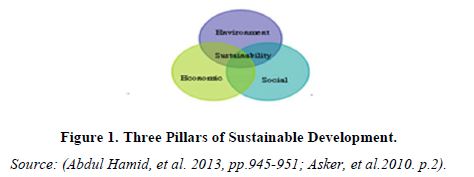

From literature review, Theory of Sustainable Tourism and from the homestay assessment indicators of the Department of Tourism. The model of factor affecting the success of homestay taking into account only the measurable factors can be shown as follow: Figure 2.
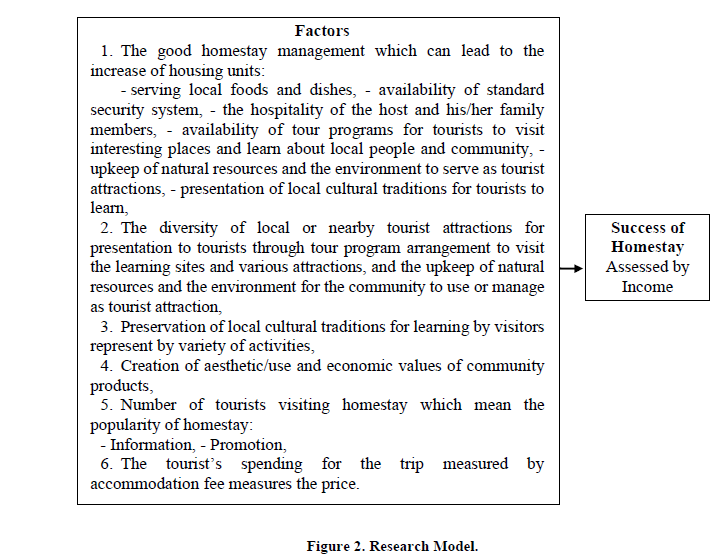

STUDY PROCEDURES
The information for this research was collected using a questionnaire and verbal interview with group leaders or representatives of all 123 homestays that had passed the inspection during 2017-2018 to obtain the Homestay Standard Thailand certificates from the Tourism Department. To answer the research objectives, the investigation was made in three parts.
Analysis of Homestay Management
The factors considered correspond to the 10 standards for inspection and certification of the Homestay Standard Thailand (Department of Tourism, 2013).
Identify the Behavior of Tourist
The factors considered are the behavior of visiting homestay, pricing, and source of information.
Determine Factors Affecting the Success of Homestay
The Measure of Success
The success of homestay can be assessed by the “income” (Duangporn, 2004). Successful homestays are popular with tourists and create sustainability for the community. As a result, people in the community have more income. From literature review a successful homestay for example: Homestay Mae Kampong (Untong, Phuangsaichai, Taweelertkunthon, & Tejawaree, 2006, p.72) revealed that Mae Kampong’s Homestay earned a total of just 80,000 baht in revenues, but by 2012, this had expanded by more than 30 times to just over 2.6 million baht. In addition, homestay business is considered a type of SMEs. For tax paying of SMEs, (The Revenue Department, 2020) SMEs will be exempt from corporate income tax if there is a net profit of not more than 300,000 baht and the excess of 300,000 baht will pay tax at the rate of 10%. This study uses this tax basis as a measure of homestay success. The success homestays can be differentiated into 2 categories: income per year over 300,000 baht represents highly successful and income per year under 300,000 baht represents moderately successful.
Factors Affecting the Success
The factors affecting the success of homestay are: (1) the good homestay management which can lead to the increase of housing units; (2) the diversity of local or nearby tourist attractions; (3) variety of activities to preserve local cultural traditions for learning; (4) number of community products to represent the creation of aesthetic/use and economic values of community products; (5) number of tourists visiting homestay which mean the popularity of homestay; and (6) the tourist’s spending for the trip measured by accommodation fee.
The Method of Analyzing
Each homestay achieves a different level of achievement (measured by income), which depends on differences in some factors. This analysis will compare the differences between homestays with highly and moderate success. In various factors with the assumption that:
Highly success homestays have more (higher) than average of the following factors: (1) More Houses for Tourists; (2) More Tourist Attractions nearby Homestay; (3) More Learning Activities; (4) More Community Products; (5) More Tourists throughout the Year; and (6) Less Accommodation Fee. Using t-test for analysis of each factor between two groups; highly successful and moderate successful homestays.
RESULTS OF THE STUDY
Thai Homestay Standard Situation
Tables 1 show that most homestays have been in operation for more than 3 years (54.47%), are located in 50 provinces of the country but most predominantly in the Northern Region (37.40%). By province, Chiang Mai has the largest number of homestays at 17 homestays. There are a total of 895 housing units, capable of accommodating 8,832 guests per day and in operation year-round. In 2018, a total of 215,327 Thai tourists took their accommodation at homestays rendering 19,617,140 baht. Foreign tourists are 51,947 creating a 7,354,126-baht total income. The homestays certified for the Thai Homestay Standard can be distinguished into five types or features namely lifestyle (53.66%), traditions and culture (47.97%) nature (43.09%), career and wisdom (20.33%), and history (11.38%).
Supply-Side Factors: Management of CBT in the Form of Homestay
The analysis was performed in relation to the criteria and indicators in the assessment for the Thai Homestay Standard certification of the Tourism Department with the findings being presented below.
Administrative Affairs: Involving three major aspects.
- Organizational Management: The homestay enterprise must be formed by a group of villagers and has a community group’s organizational structure outlining the set-up of the executive committee, organizational rules and regulations, duties and responsibilities of committee members, and the fair allocation of benefits among the stakeholders.
- Guest Relations Management: The homestay enterprise shall have a tourist reception center perhaps with a welcoming setting aimed at creating tourists’ understanding about the tour programs before escorting the tourists to guest rooms, the tourists will be accompanied by a local tour guide or the homestay host to visit attractions, do activities, shop community products, etc. until their departure.
- Accommodation Management: There is a need to have a housing and guest room preparation and cleaning system for the time before/during/after tourists’ stay, a queuing system concerning guest-room or homestay housing providers, and a system for advanced bookings, registration, payments/advanced payments, as well as clear, detailed, and up-to-date information on various fees and services.
This study found all 123 homestays have a system for organizational management involving such activities as group meeting, setting and enforcing rules and regulations, and capital mobilization; have a system for guest relations management; and have an accommodation management system particularly the financial component with the agreements; that all the money paid by tourists will be the income of the specific service providers after deduction as some percentage to be kept as the organization’s fund for use in the homestay management and administration affairs and donation for the benefits of the village community.
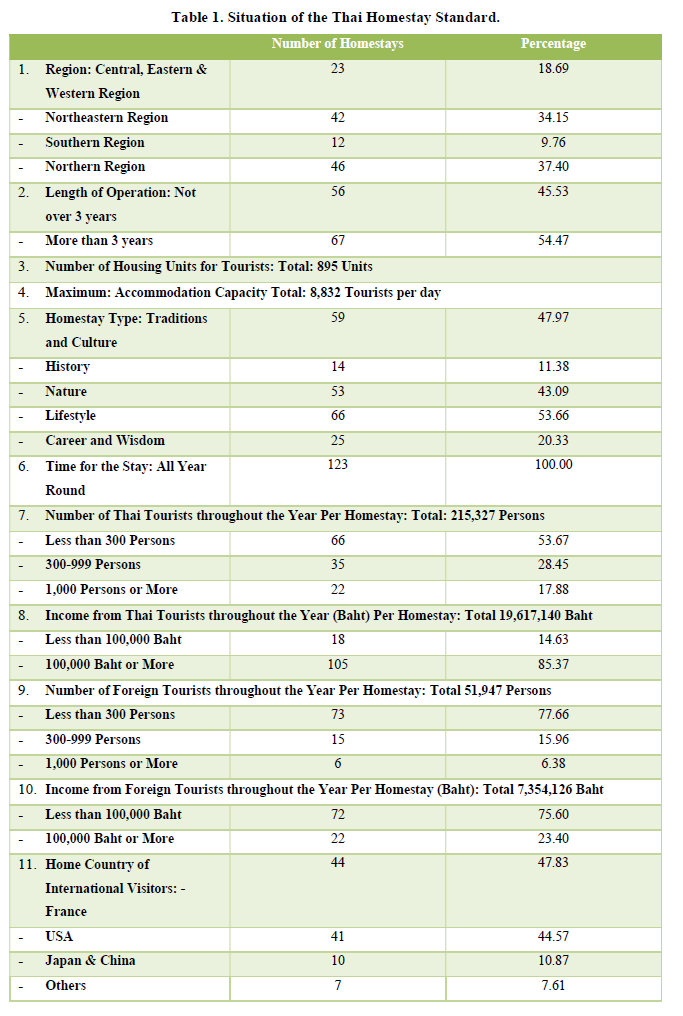
Tour Programs
Each homestay puts together the locally available tourism assets such as learning activities, attraction sites, local dishes, homestay housing, community products, cultural traditions, and lifestyle into various distinct tour programs. The tourists will have many activities to do such as visiting learning and attraction sites, trekking, boating, and biking. As shown in Table 2, the majority of homestays offer the programs with 4-6 activities (54.47%). The most popular activity included in the tour programs is learning the local art performance (69.11%). In these at various learning sites or centers, the local wise man or community philosopher will be the one giving tourists the knowledge and demonstration.
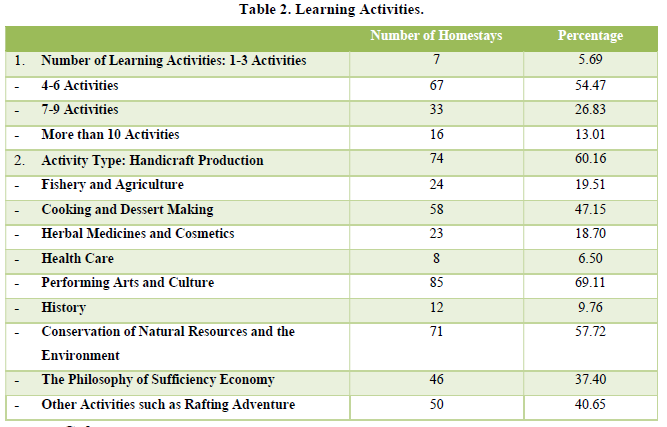

Culture
The homestay businesses have a role to play in preserving the local cultural traditions and making them known to outsiders through various means such as story-telling, practical exercise, experiment, demonstration, and performance. Furthermore, they also maintain the normal local routines and lifestyle as the folk culture such as cultural beliefs about Phi Ta Khon (masked ghosts) and worshiping ancestral spirits; walks of life including rice cultivation, fruit orchard farming, fishery, para rubber agriculture; vernacular architecture: traditional Thai-styled houses, riverside houses; handicrafts: weaving, basketry, wood carving; historical site: museum, temple; oral history and archeology: community history. This study found all 123 homestays had arranged programs to introduce their cultural heritages to visitors.
Natural Resources and the Environment
Various homestays have taken part in the larger community’s effort in the proper management and upkeep of natural tourist attractions and have conservation plans as well as the arrangement of activities to reduce the negative impacts of tourism on the condition of temple, historical and archeological structure or site, museum, waterfall, forest and hill, stream, etc. Specifically, various types of green activities have been arranged to improve natural resources and the environment such as tree planting event, mangrove forest replanting, biking, etc. Table 3 showed that the 123 homestays are located in a close proximity to tourist attractions in the local community and nearby communities. Most homestays (73.98%) have 2-5 tourist attractions within a 5 km radius and most of the nearby tourist attractions (76.42%) are in the category of the archeological site, temple, ancient building or structure, and museum.
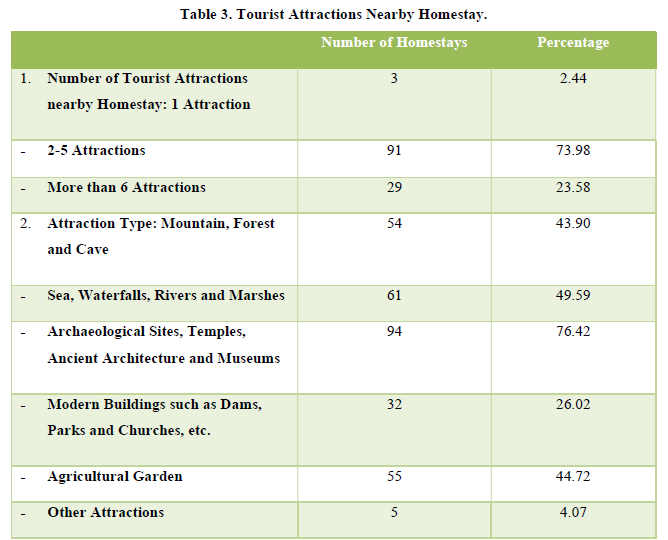

Creation of Value for Community Products
Homestays selling products produced or crafted using local raw materials by villager/community group/OTOP enterprise to tourists to take home as souvenir or memento. The community products include farm produce such as milled rice, lime, chili pepper, chemical-free vegetables, and fruits; handicrafts such as wicker works made from bamboo, sedge, rattan, and pandan leaves, as well as hand-woven textile using yarns dyed with natural colorants and carved wood items; processed products such as snack, foods, cosmetics, herbal medicines, soap, skin lotion; food from the sea like fresh seafood and dried marine products; and hill-tribe products such as tribal upper garment, scarf, trousers, and tablecloth. Table 4 presents the findings on the involvement of the 123 homestays in the creation of value for community products by selling them as a gift to tourists. The majority of homestays (76.42%) had 2-5 community products for selling and the most popular product type was local food and snack (70.73%).
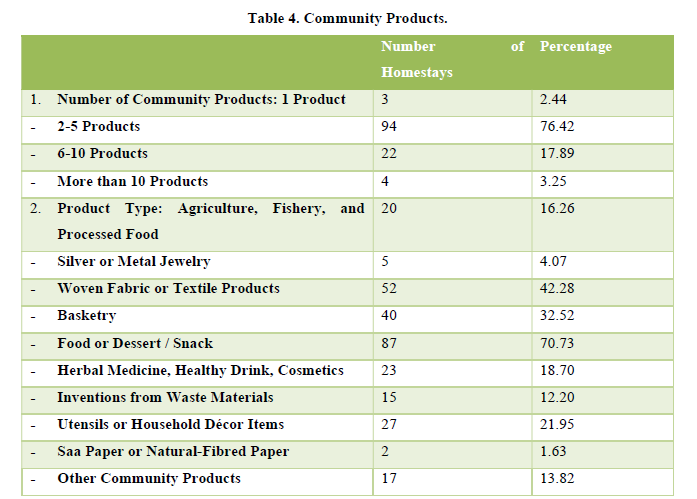

Accommodation
Each homestay enterprise arranged to offer rooms and space in houses of its members for visitors to stay and use. The houses are of many styles and features such as traditional Thai houses, hill-tribe houses, thatch-roofed houses and houses in the paddy field etc. Room for tourist accommodation in the house is generally not used by the family and the family members are willing to have it converted into a guest-room in conformation to the Thai Homestay Standard. Each certified homestay must have at least three units of housing that provide homestay services. Table 5 presents the findings on the accommodation conditions. Of all homestays, 40.65% have 4-5 units of housing. Most homestays (38.21%) can accommodate 21-50 tourists at a time. Each house for tourist accommodation is generally well proportioned, with clean and comfortable bedding in the guest-room and clean bathroom and toilet for privately accessing.
Food
Homestays generally provide home-cooked meals using local ingredients for visitors to share and some also involve visitors in the home-cooking activity for their learning experience. However, in case of having a large tourist group, the homestay might make an arrangement for tourists staying in different housing units to have meals together at the tourist reception center. In general, a meal comprises two kinds of dishes. One is the local signature dish such as Khao Purb Lom Yak - cooked fillings wrapped in fresh rice noodle sheet large enough to serve a giant - presented by Ban Na Ton Chan Homestay in Sukhothai. The other kind is the simple and common dishes with vegetables or eggs as the main ingredient. This study found all 123 homestays served food that used locally available ingredients.
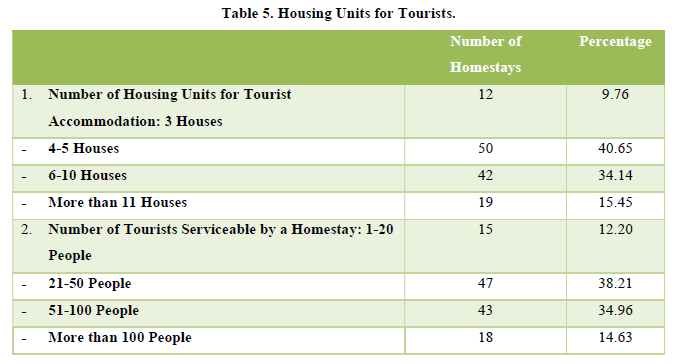

Safety
All homestays have made arrangements for tourists’ safety, and first-aid preparation with a complete set of generic drugs and household remedies in every housing unit. The tour program that includes activities with a potential risk of injury or accident such as trekking and rafting will be led by a local tour guide. Furthermore, a list of important emergency phone numbers is displayed where it is easy for tourists to notice. This study found that all 123 homestays have the safety and security measures in place as they are also a part of a fundamental public policy that the state implements in all village community.
Hospitality
The hospitality of the host and his/her family members is crucial for making tourists who spend a stay at his/her home feel impressed with everything. Therefore, it is important for the host to get a welcoming setting ready to create familiarity and opportunities to exchange information about community life. There are many ways to welcome the visitors that can be used in combinations namely having a receiving line, presentation of garland or fresh flower brooch, serving welcome fruit or herbal drink, serving snacks, presentation of local performing art or traditional dance and arranging the Thai blessing ceremony. It was found from this study that all 123 homestays had arranged assorted activities to create familiarity with tourists.
Public Relations
Generally, tourists indicated they received information about specific homestay from word of mouth or were told by some agencies or individuals who used to visit the place. However, different homestay had used different forms of public relations or advertisement to attract potential visitors. As presented in Table 6, this study found all homestays (100.00%) used brochure while some (52.03 %) also used Facebook / Page / Website, and some (17.07%) also used the services of tour companies. Yet, these media have contents that are rather not up-to-date and not effective for marketing to reach the target tourist group because they were prepared and produced by the supporting government agencies.


Demand-Side Factors
The information from community leaders or community representatives concerning the tourists or the demand-side factors was analyzed which gave the following findings presented in Table 7.
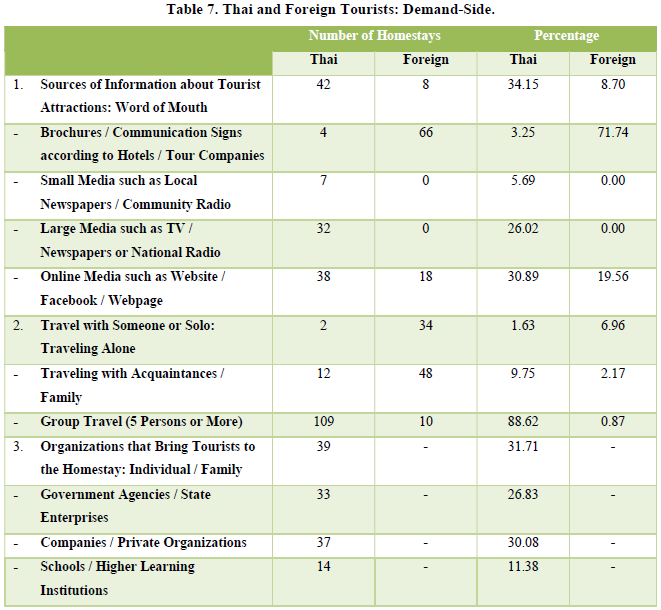

Thai Tourists
The study on various aspects about Thai tourists show that most Thai tourists (34.15%) received information by word of mouth about the CBT sites. The majority of Thai tourists (88.62%) traveled in a group (5 persons or more).
This finding is consistent with the information from interviewing the community leaders and relevant persons those Thai tourists have the tendency not to visit rural community by themselves but most of them tend to come in a group with others in the same organization or circle. Thus, Thai tourists coming in a group account for a large proportion (88.62%) of all Thai guests of homestays. The travel program to visit and stay in a village community is pertinent for (1.1) other villagers or communities: to take a field study and an in-depth learning to gain knowledge for application in their own profession; (1.2) private business and non-government organization: to undertake activities that reflect the Corporate Social Responsibility (CSR) with the local community with which the business or the organization has involved; and (1.3) children and youth above grade 4: to learn about community life and traditional Thai wisdom and knowledge.
Foreign Visitors
The study shows that 76.42% of homestays had received foreign visitors and most of which (77.66%) got less than 300 foreign guests per year and mostly (75.60 %) earned income from foreign visitors less than 100,000 baht per year. The most common source of information concerning homestays for foreign tourists was found to be brochure/information board or display at hotel/tour companies (71.74%). Most foreign visitors (89.13%) either traveled alone or traveled with acquaintance/family.
The main purpose of international travelers to visit Thailand includes their interest to explore natural attractions, understand the Thai traditional cultures, way of life, and folk wisdom, eat Thai food, and shop Thai products. It was observed that relevant Thai government agencies have not yet run an adequate promotion for them. Especially, there is a paucity of detailed information available at hotels/tour companies.
Success of CBT in the Form of Homestay
Table 8 presents the findings on various aspects of the homestays’ performance. Most homestays (85.37%) were highly successful financially while other homestays were moderate successful (14.63%). More than a half of all homestays (52.85%) received more than 300 visitors per year. Total income gained were 27,025,267 baht. Each homestay can earn 747 baht from a visitor for an overnight stay, three meals, and learning activities.
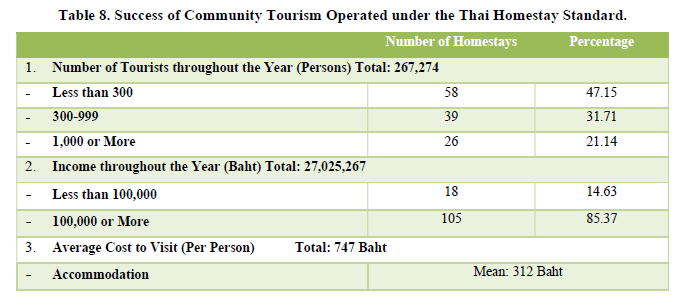



Factors Affecting the Business Success of CBT in the Form of Homestay
Table 9 indicate the relative role of supply-side and demand-side factors in contributing to the success of homestay operation. As for the supply-side factors, the number of housing units as an indicator of the good homestay management is statistically significant at the 0.001 level and the availability of learning activities involving performing art and culture is also significant at the 0.001 level while the tourist’s expenditure which is the demand-side factor is statistically significant at the 0.05 level. This implies that the factors on the supply side have a greater bearing on the success of homestay operation relative to the demand-side factor.
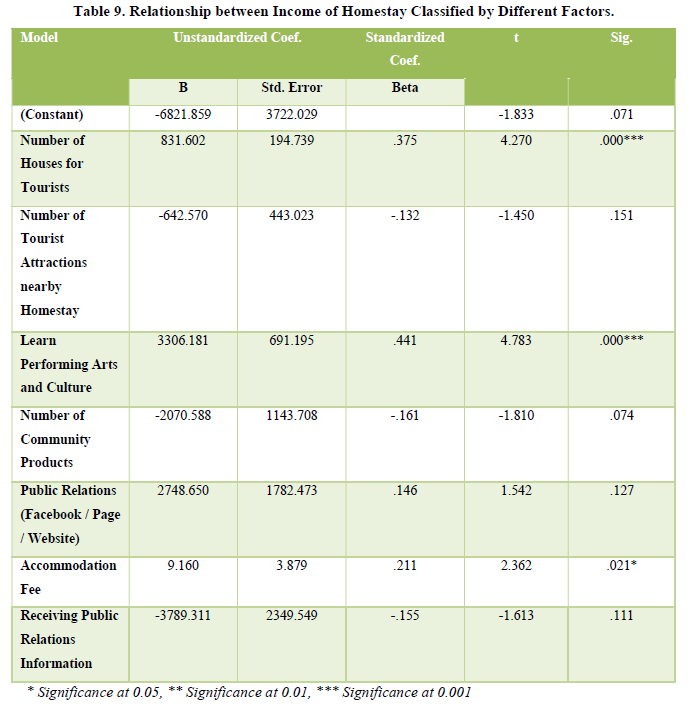

CONCLUSIONS AND DISCUSSION
Thai Homestay Standard Situation
Homestay guests are Thai tourists more than international tourists but income per visitor a homestay can get is more from foreign tourists than from Thai tourists due to the higher service charge.
Supply-Side Factors
Number of housing units to accommodate tourists is still small, but homestays have the capability to impress visitors. Homestays have weaknesses in not able to introduce the learning activities program interesting enough for visitors nor to handle the marketing affairs as a professional hand and homestays are the proper choice for group of people pursuing field study/visit and learning experience.
Demand-Side Factor
Thai Tourists: Individuals preferring traveling in a group like those from other village or community; participants in program organized by government agencies for field study and in-depth learning for future occupational development; schoolchildren and youth above grade 4 to learn about rural community life and Thai traditional wisdom and knowledge; and participants in CSR activities arranged by private business or non-government organization that has an association with the homestay enterprise.
Foreign Tourists: Generally, with a travel objective to learn various aspects of the Thai culture, prefer traveling solo or in a small group, spend relatively more than the Thai counterpart for homestay vacation, are small in number as the most common source of information about homestay for them is only in the category of brochure/information board at hotel/tour company.
Factors Affecting the Business Success of CBT in the Form of Homestay
Most homestays are successful in their operation for the reasons described below.
Good Homestay Management: Indicators of good management include the inclusion of adequate accommodation units, serving dishes made from local ingredients, availability of standard safety and security systems, and the hospitality of the host and family members. The expansion of homestay housing units can confer benefits to other members in the local community in terms of more jobs for the local villagers, and enhancement of community unity and strength.
Availability of Learning Activities about Performing Arts and Cultural Shows: Homestays could attract more visitors to the local community when they tried to revive and conserve performing arts and cultural shows as well as create the story for presentation to visitors in various interesting ways.
Homestay Charging Reasonable Prices: which makes tourists feel it is worthwhile for them to visit the community and take homestay accommodation.
RECOMMENDATIONS
Supply-Side Considerations
The Tourism Department must encourage the local communities to run their homestays in compliance more with the Thai Homestay Standard by involving educational institutions to work as mentors in various aspects.
Other local agencies such as educational institutions and Provincial Office of Tourism and Sports should play roles in providing knowledge, creating understanding, and increasing the experience to enable the homestays to make their presentation of learning activities more interesting for visitors and do their business marketing at the professional-like level.
The Ministry of Finance can establish measures to encourage private organizations or businesses or tour operator to use homestay services, for example, by allowing the private business that brings its staff to do activities and stay at a homestay to claim the homestay-related expenditure as tax deductible expense.
Demand-Side Considerations
Thai tourists: Each homestay must provide information to local governments, government agencies, non-government organizations, businesses, and educational institutes through a letter attached with brochures describing the learning activities and tour programs and inviting them to use its services.
Foreign tourists: Homestays must develop community tourism program in cooperation with hotels and tour companies through the coordinating and event organizing roles of various Provincial Offices of Tourism and Sports. The arranged programs then are advertised through brochure / information boards / Website / Page / Facebook as well as the public relations channels of hotels/tour operators.
The Ministry of Tourism and Sports and the Ministry of Education work in cooperation establishing a policy to encourage educational institutes to take schoolchildren and students for extra-curriculum experience outside school or off-campus at Homestays Thai Standard.
- Abdul Hamid, M., Ismail, N., & Mohd Fuza, F. I. (2013). Defining sustainability concept in tourism product. Proceedings of the 3rd Regional Conference on Tourism Research 23-31: 945-951.
- Akkarangkul, S. (2008). Tourist Behavior (4th ed.). Khon kaen: Kluangnana vitthaya press.
- Association of Southeast Asian Nations. (2016). Asean community-based tourism standard. Available online at: https://goo.gl/ypkgYC
- Bungon, S., I Gede, D., Sirikiet, R., & Ariya, P., (2018). Factors determining the sustainable success of community-based tourism: Evidence of good corporate governance of Mae Kam Pong Homestay, Thailand. International Journal of Business and Economic Affairs 3(1): 13-20.
- Jittangwattana, B. (2005). Sustainable Tourism Development. Bangkok: press & design.
- M.N. Ismawi, I., M. Hafiz, H., Norliza, A., & Norazah, M., (2016). Community-based homestay service quality, visitor satisfaction, and behavioral intention. Proceedings of Social and Behavioral Sciences 222: 398-405.
- Nick, K., Anuwat, C., & Varaphorn, D., (2015). Homestay tourism and the commercialization of the rural home in Thailand. Asia Pacific Journal of Tourism Research 20(1): 29-50.
- Suansri, P., & Ricards, P. (2013). Directions towards a credible and high-quality Thai community-based tourism standard. Bangkok, Thailand: Winida karnpim limited partnership.
- United Nations World Tourism Organization. (2013). Sustainable tourism for development guidebook. Available online at: http://goo.gl/CiofJY
- Untong, A., Phuangsaichai, S., Taweelertkunthon, N., & Tejawaree, J. (2006). Income distribution and community-based tourism: Three case studies in Thailand. Journal of GMS Development Studies 3(1): 69-81.
- Velan, K. & Rosazman, H. (2017). Challenges of community-based homestay programme in Sabah, Malaysia: Hopeful or hopeless. Journal of Tourism Management Perspectives 21: 1-9.



